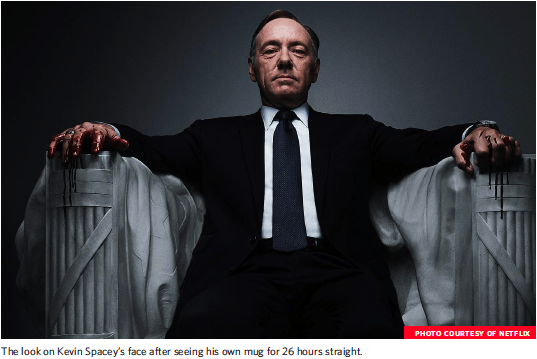Like most of my peers, I took Valentine’s Day to…not…do…Valentine’s things.
Nope, my date was with the second season of House of Cards, a show that, like all other Netflix original programming, is released on a per season basis, with all the episodes premiering at once.
And of course, all the assignments that had piled up one by one for the last month, the “due right after reading week” ones, fell by the wayside.
Welcome to the world of binge watching, the best drug you never knew you were addicted to.
The advent of all-you-can-consume TV has given way to accessible marathons of entire seasons or runs of TV shows and miniseries, an idea that seems harmless at first, even pretty good for your own watching (instant gratification, no commercial breaks).
However, there’s an edge to binge watching that belies its harmless run of “26 episodes in two days” fun. I suppose it’s all in the title, right?
Binge. Watching.
A recent poll of 1,275 Canadians done by Head Research shows that on average, viewers have watched three or more episodes of any given show back to back in a year, averaging out at about four episodes a week and 4.6 on weekends.
I don’t know about you, but this seems somewhat endemic. Given the fact that most binge viewers are between 16 and 35 years old, according to a report issued by Magid Generational Strategies, I now know why just about every aspect of my life is suffering except my ability to brazenly quote The Wire.
Many shows are calculated to be compulsively watchable.
A common criticism of the new House of Cards season was the show chose to forego depth in favor of an almost scientifically calculated approach to keeping the viewer moving from one episode immediately into the next.
This creates a vicious cycle of content absorption, and you may come to at 3 a.m., two nights after you’ve started, having seen more of Frank Underwood’s rise to power, and already begun scrolling through your Netflix queue, wondering, what’s next?
This is a sign of addiction, and is murderous to work ethic, the immediate gratification aspects of watching a series from start to finish not having the patient reward or anticipation of the weekly show.
I’ve lost track of the shows I’ve binged. It’s not really a problem, but it’s a problem. Already classified as an addiction in anything but diagnosable terms, binge watching can often regress into a glazed set of hours without anything getting done, moving from fix to fix as seasons of television disappear within days.
There’s a proven chemical response that your brain releases as it moves from episode to episode of reality blurring nothingness, and it’s a powerful drug. According to Netflix’s data, about 61 per cent of people who subscribe to their service engage in binge watching.
Others consider binge watching a form of empowerment, akin to going out to watch a movie or taking the time to read a book—a constructed set of hours in which you are one with the television screen, taking in the particulars of the experience.
Yeah, right. Try saying that after a two-season run of Downton Abbey, immediately followed by Hell on Wheels. Most binge watching is done accidentally.
“Accidentally.”
It’s a kind of addiction unique to our age, one built on information and consumption of information, for better or worse. Binge watching is great in moderation, when you’ve hoarded every episode of True Detective waiting for the end of the season so you can watch it all, for example.
But it can also be habitual. As midterms pass us by and the end of the year draws close, just remember, kids. Frank Underwood can wait.
Abdul Malik
Arts Editor


